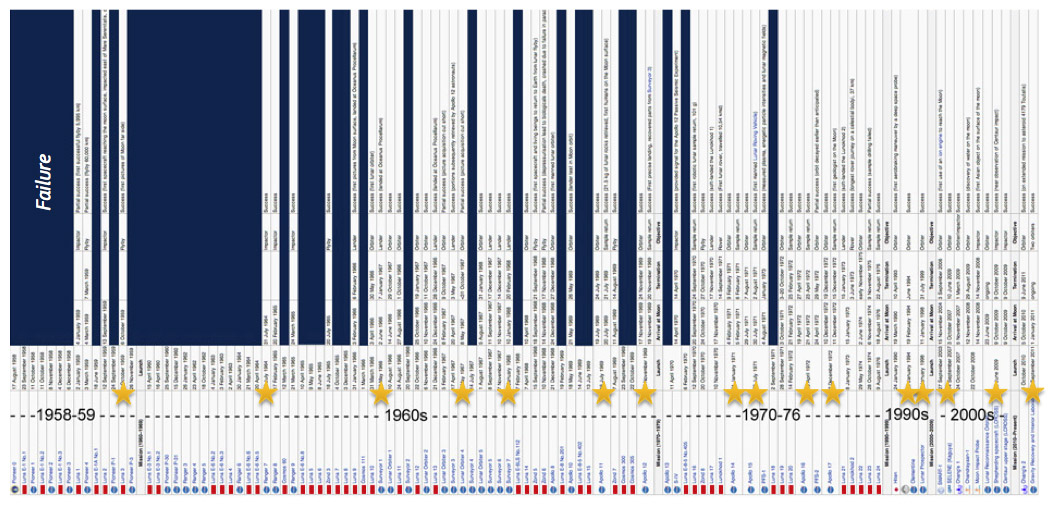January 2, 2013
Gold Stars for Lunar Science

Wikipedia list modified by Chuck Wood
In preparation for a talk later this week I looked in vain for a chart showing the chronology of lunar missions and finally constructed this one. I took the listing in the Wikipedia article on Lunar Exploration, turned it on its side and added a few things. Most obvious are the dark columns for missions that failed. I also added the date ranges, and the gold stars. This chart points out a number of things:
(1) there have been lots of lunar missions! A huge proportion of the early ones were failures - in fact, it wasn't until Apollo 12 that the number of successes equalled the number of failures. (And that was followed by Apollo 13, the US's last failure.) According to the Wikipedia list criteria, the last lunar mission failure was Luna 18 in 1971; I would consider Luna 23 in 1974 to be a failure. Since then all lunar missions have succeeded. Hooray.
(2) From 1976 to 1990 there were no missions to the Moon! What the hell happened to the human race?
(3) Since the minimalistic Hitan probe in 1990, 60% of lunar spacecraft have been launched by countries other than the US, specifically Japan, Europe, China, and India. Russia has launched no lunar spacecraft since 1976. China seems to be the only country with orderly plans to continue exploring the Moon, with a lander to be launched this year.
(4) Not all missions have been equally valuable scientifically. The yellow stars are my estimation of missions that achieved major scientific discoveries. There are not stars for missions like Luna 2, Luna 9, most Surveyors and Lunar Orbiters, and Apollo 8 and 13 because, despite being historic, heroic or invaluable for engineering, they did not contribute revolutionary improvements in understanding of the Moon. Luna 3 did because its grainy images first showed that the farside was not the same as the nearside. Ranger 7 demonstrated that craters continued to be the dominant landform down to meter scales - the Moon did not have a smooth surface. The third star is for Surveyor 1, the first scientifically bountiful soft lander that, as did Luna 9, demonstrated that the surface is strong, and that it had a grainy/pebbly texture that was the first documentation of the regolith. Lunar Orbiter 4 gave scientists high resolution images of most of the Moon, providing critical imaging used for 25 years to interpret lunar history. Surveyor 7 is the fifth gold star because of the lander's chemical analyses of highlands rocks showed that they were rich in aluminum and deficient in iron compared to mare rocks. Every one of the Apollo missions that landed deserves multiple gold stars because analysis of the samples collected are arguably the most important data in all of planetary geology. Samples provide exhaustive information on the composition, origin and ages of lunar materials. Without dated Apollo sample we would not have a strong basis for a timescale for moons and planets in the solar system. From Apollo 17 to the next gold star, Clementine, was a wasted 22 years. Clementine detected the possibility of water ice in the polar craters but more importantly provided the first global topographic, gravity and compositional data, especially for iron and titanium. Four years later the plucky - and cheap - Lunar Prospector yielded improved geophysical and geochemical data that led to recognition of the Procellarum KREEP Terrain (PKT), the most unique large-scale terrain on the Moon. Lunar Prospector also discovered new mascons and mapped magnetic anomalies. The next gold star goes to Kaguya, possibly the most important lunar mission since Apollo. Kaguya benefited from new generations of detectors, producing a continuing series of mineralogical discoveries because of improved resolution and sensitivity. Lunar Reconnaissance Orbiter has increased imaging resolution one to two orders of magnitude, revealing unexpected details about impact melt, surface fracturing and many other geologic processes. Its LOLA altimeter has revolutionized knowledge of lunar topography on all scales and its other sensors provide temperature and radar data that are unparalleled. And the co-launched LCROSS finally documented polar ices. Finally, the recently completed GRAIL mission has provided very high quality gravity data that is allowing mapping the 3-D structure of the lunar interior, already yielding important discoveries.
OK, let's have criticisms and additional comments (I have some)!
Chuck Wood
Afterthought: As a mission Chandrayaan-1 was about average in scientific advances, but it probably should be starred because its Mini-RF radar and especially the Moon Mineralogy Mapper (M3) have yielded important new information.
Yesterday's LPOD: Comments?
Tomorrow's LPOD: Comments?
COMMENTS?
Register, Log in, and join in the comments.



